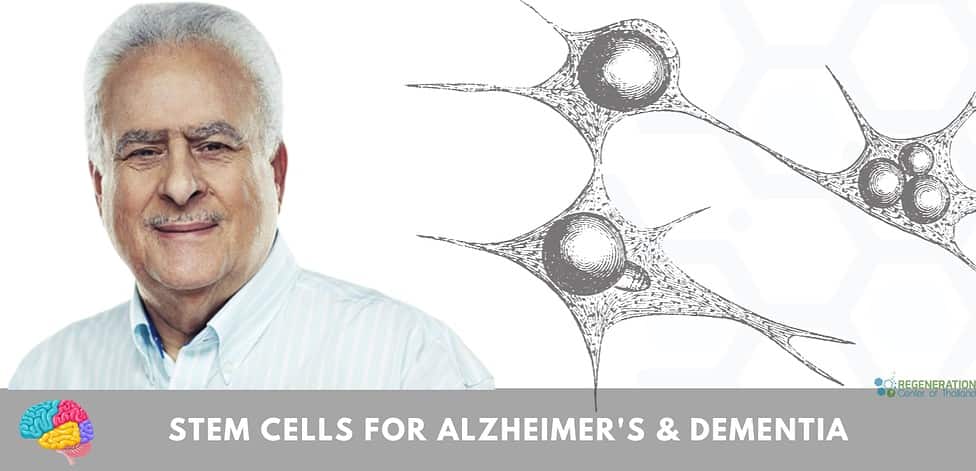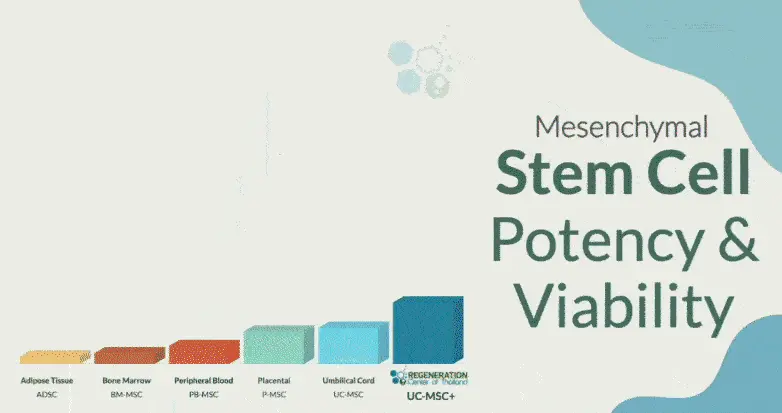Alzheimer’s, also known in medical literature as Alzheimer’s Disease (AD), is the most common type of dementia. As of today, there are no effective pharmaceutical-based therapies for the illness, but stem cell treatment for Alzheimer’s disease provides the potential to repair the damage caused by Alzheimer’s and improve cognitive function.
The condition is terminal and, if left untreated, will eventually lead to death. AD is generally diagnosed in older adults aged sixty-five years, but of course, it can also occur at an earlier age. In 2020, an estimated 59 million people were suffering from AD throughout the world. Alzheimer’s is predicted to affect one in every eighty individuals globally by the year 2040.[1] As recently as last year, the diagnosis has quickly skyrocketed to become the fifth most significant cause of death worldwide. Alzheimer’s makes up about 70% of these cases. Some medical researchers have also recently begun to consider the possibility of Alzheimer’s being an autoimmune brain disease. Patients with Axial spondyloarthritis have a higher chance of getting diagnosed with Alzheimer’s dementia. Alzheimer’s disease is currently diagnosed based on several factors, including amyloid plaques and tau tangles, “neurofibrillary tangles” (NFTs), which are toxic proteins in the brain tissue and result in cognitive decline and eventually dementia. These self-propagating prion proteins are amyloid beta (A-β) and Tau. Patients with higher levels of these prions and beta-amyloid plaque are associated with early-onset Alzheimers. New studies have also found over 215 genes that counter ApoE2 protection and ApoE4 risk. For some patients, the expression was linked to genome-wide association study variants and focused on genes involved in the synaptic function, regulation of lipoproteins, and neuroinflammation.
What are Prions & Double-Prion Disorders?
Amyloid Plaques and Neurofibrillary Tangles – Prions are defective proteins that spread similar to infections in the human body. These proteins force good copies of proteins into the broken, misfolded shapes that destroy the brain. The 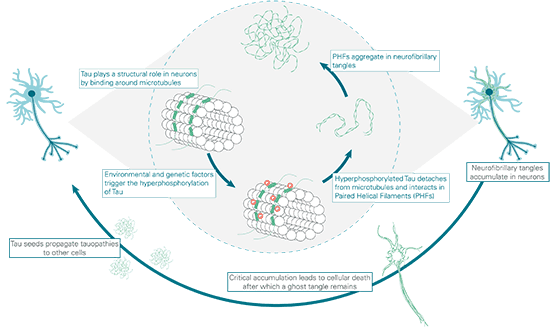 Double-prion disorder refers to the two rogue proteins Tau and amyloid beta. Recent research has shown clear underlying causes of neurodegenerative diseases caused by a consistent buildup of misfolded tau proteins (β amyloid plaques and tangles) that are sometimes referred to as “prion-like.” It can now be measured much quicker than in the past. Other identified Prion Diseases include Creutzfeldt-Jakob Disease (CJD), Gerstmann-Straussler-Scheinker Syndrome, Kuru disease, Variant Creutzfeldt-Jakob Disease (vCJD), and Fatal Familial Insomnia.
Double-prion disorder refers to the two rogue proteins Tau and amyloid beta. Recent research has shown clear underlying causes of neurodegenerative diseases caused by a consistent buildup of misfolded tau proteins (β amyloid plaques and tangles) that are sometimes referred to as “prion-like.” It can now be measured much quicker than in the past. Other identified Prion Diseases include Creutzfeldt-Jakob Disease (CJD), Gerstmann-Straussler-Scheinker Syndrome, Kuru disease, Variant Creutzfeldt-Jakob Disease (vCJD), and Fatal Familial Insomnia.
Signs & Symptoms of Alzheimer’s
Alzheimer’s shows a wide variety of symptoms, including personality changes and memory loss, followed by severely impaired intellectual/cognitive functions that arise from the disease itself or any trauma to the brain tissue. Such symptoms are NOT part of the normal aging cycle and are usually severe enough to impact the affected persons’ daily activities, relationships, and independence. Alzheimer’s “AD” is the most commonly known type of dementia, but there are other diagnosed forms of neurodegenerative disease, including vascular and mixed dementia.
Difference between Dementia and Alzheimer’s
Patients with dementia usually rapidly decline in memory function, learning, communication, and solving simple problems. For some, these changes take several years to occur, but for many, the neurological function deteriorates quickly and, if left untreated, will not be reversible. The rate of progression and eventual outcome of TDP-43 proteinopathy, AD, and dementia vary from patient to patient. Still, they are usually determined by the area of the brain that is affected and the type of dementia with which they are diagnosed.[2] Early diagnosis and treatment are the patient’s best hope. Thanks to modern tests for the disease, early detection is quite simple, using advanced brain imaging such as CT Scans, MRIs, clinical examinations from approved neurologists, and other diagnostic tests, including DNA Screenings. Typical symptoms & signs of Double-prion Disorders such as ALZ:
- Loss of communication skills
- Rapid Memory loss
- Motor Function, Gait and balance issues, and other symptoms of movement disorders
- Difficulty making decisions
- Difficulty with abstract thoughts
- Faulty reasoning
- Senile behavior due to cognitive impairment
- Inappropriate verbal and physical behavior
- Aphasia
- Impaired judgment
- Sundowners Syndrome
- Autonomic neuropathy
- Disorientation of time and location
- Paranoia, frequent agitation, or Hallucinations
- Complete neglect of personal hygiene and safety
People with Neuro Degenerative Alzheimer’s might also:
- Asks the same question repeatedly
- Cannot recognize family or friends
- Unable to remember or follow directions
- Frequent cognitive impairment, i.e., lost or disoriented in very familiar places
Sundown Syndrome
Sundowning or “late-day confusion” is a common neurological symptom of Alzheimer’s. Patients and family members caring for patients with the disease must know that confusion and frequent agitation might depend on the time of day. The most dangerous type of Sundowning behavior includes persistent Hallucinations or wandering away from home. Sundowners often experience pronounced symptoms in the late afternoon or evening. Sundowning usually occurs in middle-stage to advanced ALZ. 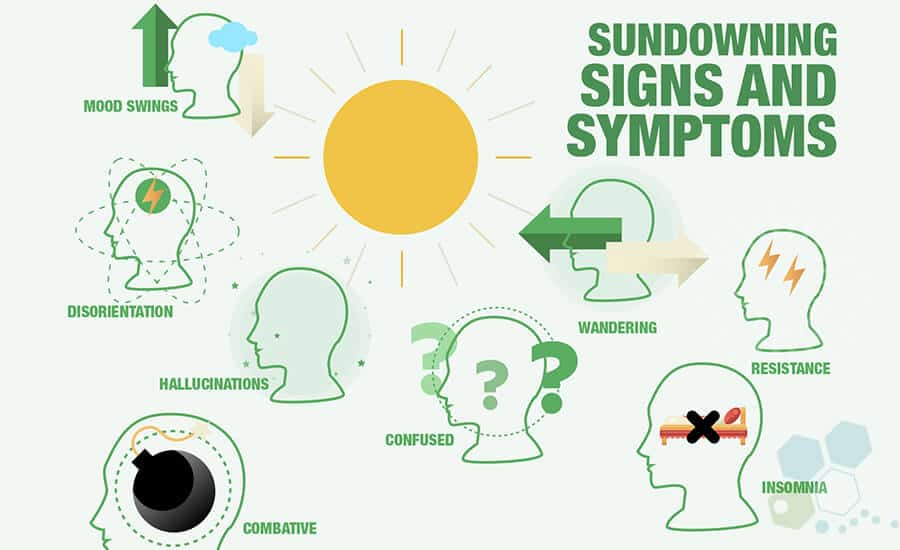
4 Types of Dementia
Disease symptoms are often very similar, which is why there is often trouble determining which type of dementia a patient might have. To make matters more complicated, some patients experience multiple types of overlapping symptoms and, therefore, get diagnosed with “mixed dementia.” There are also cases of familial Dementia; however, the odds are very low ( less than 5% of all cases), and genetic testing can be done to confirm or deny hereditary involvement. The four most common forms of dementia are:
- Alzheimer’s Disease generally occurs after a rapid buildup of tau tangles or amyloid plaque proteins (tau protein) & β amyloid plaque in the brain – the amyloid cascade hypothesis.
- Lewy Body occurs when abnormal amyloid precursor protein appears in nerve cells, impairing cell signaling or function.
- Frontotemporal – occurs when the temporal or frontal lobes of the human brain shrink or get damaged.
- Vascular – usually occurs after damage to the central nervous system after a brain stroke.
Stem Cell Treatment for Alzheimer’s
Alzheimer’s disease distinctly affects each patient, and there are still the usual indicators that one is suffering from the disease. Early warning signs are more usually misconceived to be a normal aging process or just manifestations of stress and depression. In the initial stage, the most common symptoms you can observe are difficulty remembering current happenings. Potential 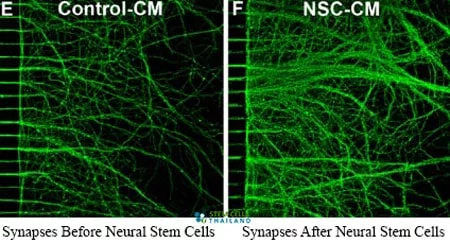 Parkinson’s Disease and AD patients can be diagnosed and verified through examinations that gauge behavior and thinking abilities, followed by a more thorough examination of Radiology scans of the brain. As the diseases become more apparent, the warning signs can include being frustrated quickly, irritated easily, growing much more hostile, having wild mood swings, difficulty in speech and language, and long-term loss of memory. Stem cell researchers have found that as patients become more and more affected, they usually isolate themselves from their families and the community. The body is affected gradually, and unfortunately, brain inflammation and systemic shutdown can lead to death.
Parkinson’s Disease and AD patients can be diagnosed and verified through examinations that gauge behavior and thinking abilities, followed by a more thorough examination of Radiology scans of the brain. As the diseases become more apparent, the warning signs can include being frustrated quickly, irritated easily, growing much more hostile, having wild mood swings, difficulty in speech and language, and long-term loss of memory. Stem cell researchers have found that as patients become more and more affected, they usually isolate themselves from their families and the community. The body is affected gradually, and unfortunately, brain inflammation and systemic shutdown can lead to death.
Does stem cell therapy work for Synaptic Failure and Alzheimer’s?
As ALS Disease, Alzheimer’s, and dementia displayed, symptoms can be similar to patients with SMA, multiple sclerosis, and Ataxia. Atherosclerosis (hardened arteries) is another common problem that leads to ischemic heart attacks, CAD, strokes, arthritis, and peripheral vascular disease, which results in a very high risk of developing Alzheimer’s disease. Consequently, so many variables make predicting how it will play out harder. AD could worsen without the patient’s knowledge and be left undiscovered for a long time. The usual lifespan for people diagnosed with Alzheimer’s is roughly three to seven years. According to Alzheimer’s researchers, Less than three percent of patients can live up to fourteen years or longer after being diagnosed with AD.[3] This stage is where enhanced mesenchymal stem cells can be used to treat Alzheimer’s disease. Learn more about cellular therapies
Neural Stem Cell Treatment for Dementia – 2025 Protocol
There are a few medications that have been researched and approved for the treatment of cognitive symptoms due to Alzheimer’s disease, including cholinesterase inhibitors (Exelon, Aricept, Razadyne) and memantine HCl (Namenda). Side effects of these medications include vomiting, loss of appetite, nausea, constipation, confusion, dizziness, headaches, and chronic bowel movements. For those with early onset Alzheimer’s or who have not responded well to traditional ALZ medications, The Regeneration Center offers a unique and effective treatment plan to repair brain damage caused by Lewy body.
Stem cell research and clinical trials.
Our functional therapies use multiple types of cellular lines, neurotrophic growth factors, and exogenous and endogenous cells to induce synaptogenesis, which helps replenish damaged/lost neuronal connection/signal systems and helps reduce amyloid plaque in the brain’s hippocampus region. Endogenous cultured cells from the human umbilical cord offer anti-inflammatory, immunomodulation capacity with anti-apoptotic activity and introduce neurogenic properties to the damaged areas of the human brain where they proliferate and mature into neurotransmitters, tnf α, and functional derived neurons. Sensory precursor cells and nerve growth factors can be given intravenously or directly implanted in central nervous system areas to help promote the very of the patient.
Can stem cell transplants improve memory?
There is also substantial proof that transplanted brain cells or neural precursor cells (NPCs) can survive and gradually develop into neurons, oligodendrocytes, and astrocytes ( via a process known as neurogenesis. Stemcells from dental pulp and cord tissue derived UC-MSC+ to replace lost and damaged function and delay progression of Alzheimer’s disease and cell death. Other cellular lineages and cell types needed for neurodegenerative disorders include neuron progenitor cells to help induce endogenous neural precursors, help boost the structural neuroplasticity, vascular endothelial growth factors, and nerve growth factors to increase pro-inflammatory cytokines such as tnf α and Interleukin–1 beta (IL–1β) to halt neuronal apoptosis.[4]
What role do stem cells play in Alzheimer’s disease?
Somatic motor neurons can also be modified using cell growth factors to push growth factors into the brain. Studies indicate that the full-grown brain of mammals preserves the capability to produce new neurons from the neural stem or progenitor cells. Stemcells for memory loss are one of the most practical and effective ways to bypass the blood brain barrier and repair the damage in the entorhinal cortex caused by brain injuries, brain fog, Strokes, and Alzheimer’s (to improve memory), help to restore intellectual function with quality of life for the patient affected by the disease.[5]
Neural Stem cells and isolated exosomes, extracellular vesicles, have the potential to repair the damage caused by Alzheimer’s and improve the cognitive function of patients with brain injuries and motor neuron disease. Human neural stem cells and neural precursor cells also improve cognitive function for people with Alzheimer’s.
Stem cells for Alzheimer’s disease
Current stem cell applications for Alzheimer’s disease can include:
- Cell Replacement Therapy – Stem cells and different cell growth factors are isolated in our stem cell lab to differentiate into cholinergic neurons and other nerve cells damaged by Alzheimer’s. These new neurons could integrate into brain circuits to rebuild lost connections and function.
- Growth Factor Secretion—Transplanted UC-MSC+ stem cells secrete trophic and neurite-promoting factors that could stimulate the brain’s innate stem cells and support remaining healthy host neurons in a paracrine fashion.
- Anti-Inflammatory Effects – Managing the disease can be challenging, but stem cells release immunomodulatory cytokines, different cell types, and chemokines that may help suppress chronic inflammation associated with Alzheimer’s neurodegeneration.
- Targeted Delivery of Cultured Neural Cells—The Regeneration Center offers unique proprietary stem cell technology with healthy stem cells that can be given via IV and Intrathecal application for direct delivery to cerebrospinal fluid, which defines the homing path from the point of injection. Our cell-delivery methods can bypass the blood-brain barrier and are engineered to deliver neuroprotective or enzyme-replacing substances to enhance amyloid clearance.
Regenerative Medicine for Alzheimer’s
Regenerative medicine approaches for Alzheimer’s disease focus on repairing or replacing damaged brain tissue and neurons to slow or potentially reverse cognitive decline. Key strategies include stem cell therapies, where neural stem cells or induced pluripotent stem cells are transplanted to generate new neurons and support cells. The Regeneration Center is also exploring ways to stimulate endogenous neurogenesis and promote a regenerative environment in the brain. This may involve using neural cell growth factors, gene therapies (currently unavailable), or small molecules to activate resident neural stem cells and enhance their ability to produce new neurons. Additionally, efforts are underway to develop biomaterials and scaffolds supporting cell growth and integration in damaged brain areas. These approaches offer hope for more effective treatments that could potentially restore lost cognitive function in Alzheimer’s patients.
TREATMENT RISKS & PRECAUTIONS
Please note that not all patients are suitable candidates for Neural Stem Cell Therapy for Alzheimer’s, Vascular Dementia, neurological and spinal conditions, or Lewy Body Dementia. Patients with advanced cognitive decline, severe neurological deterioration, or other critical health conditions might not be good candidates for treatment. The Regeneration Center does not offer Gene therapy, induced pluripotent stem cells (iPSC), or embryonic stem cells to treat Alzheimer’s or vascular dementia.Cost of Stem Cell Therapy for Alzheimer’s Disease
The Regeneration Center treatment protocol for Alzheimer’s disease using mesenchymal stem cell transplantation with neural cells will require approximately two weeks in Bangkok. Due to varying degrees of cognitive and physical degeneration, our team must review any patient health files before acceptance. Once our review is complete, we can offer a detailed treatment plan that includes the complete treatment steps, including the types and quantities of transplanted cells (multiple cell types, including pluripotent stem cells), treatment costs, and total nights required for treatment.
Rehabilitation Post-Therapy – Physical rehab sessions after treatment are optional but highly recommended in Thailand or your home country. Living with ALZ disease is challenging, and depending on the patient’s timing constraints, physical rehab can be provided upon request for 2-4 hours per day and up to 6 days per week. In addition, visas and extended stay accommodations at a hotel or furnished apartments for the patient and family can also be provided upon request.
To begin the qualification process for our multi-stage regenerative medicine protocol, please prepare your recent health records and radiology scans from Brain MRIs, PET scans, or CT Scans and contact us today.
Published Clinical Citations
[1] ^ Blurton-Jones, Mathew, Brian Spencer, Sara Michael, Nicholas A Castello, Andranik A Agazaryan, Joy L Davis, Franz-Josef Müller, Jeanne F Loring, Eliezer Masliah, and Frank M LaFerla. 2014. Neural stem cells genetically-modified to express neprilysin reduce pathology in Alzheimer transgenic models. Human umbilical cord Stem cell research & therapy clinical trial, no. 2 (April 16). doi:10.1186/scrt440. https://www.ncbi.nlm.nih.gov/pubmed/25022790
[2] ^ Cook, Casey, Yong-jie Zhang, Ya-fei Xu, Dennis W Dickson, and Leonard Petrucelli. 2008. TDP-43 in neurodegenerative disorders. Expert opinion on biological therapy, no. 7. doi:10.1517/14712598.8.7.969. https://www.ncbi.nlm.nih.gov/pubmed/18549326
[3] ^Suksuphew S, Neural stem cells could serve as a therapeutic material for age-related neurodegenerative diseases in Thailand. World Journal of Stem Cells. 2015;7(2):502–511. doi: 10.4252/wjsc.v7.i2.502. https://pubmed.ncbi.nlm.nih.gov/25815135/
[4] ^ Taupin P. Adult neural stem cells, neurogenic niches, and cellular therapy. Stem Cell Rev. 2006;2(3):213–219 https://www.ncbi.nlm.nih.gov/pubmed/24783773
[5] ^ Fitzsimons, Carlos P, Emma van Bodegraven, Marijn Schouten, Roy Lardenoije, Konstantinos Kompotis, Gunter Kenis, Mark van den Hurk, et al. 2014. Epigenetic regulation of adult neural stem cells: implications for Alzheimer’s disease. Molecular neurodegeneration (June 25). doi:10.1186/1750-1326-9-25. https://www.ncbi.nlm.nih.gov/pubmed/24964731

